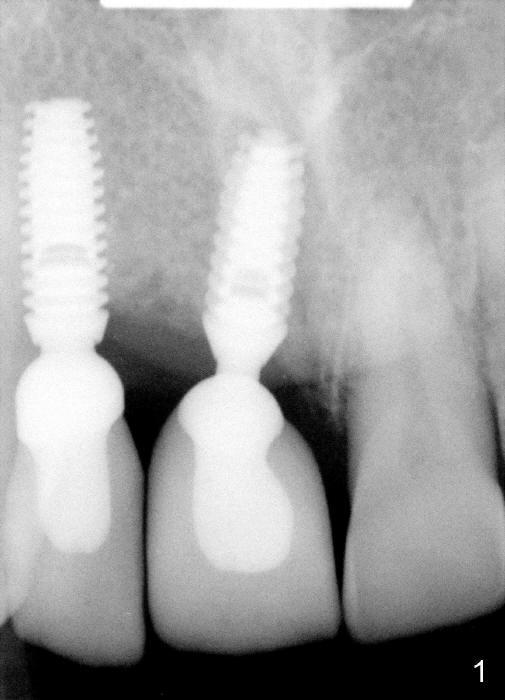
 |
How to tell whether IAC or Bicon Abutment is completely seated?
IACs were seated for Sergio last week as shown by Fig.1. A few days later, he reported that the crown(s) was/were loose. Did I show you in web how to tell whether an IAC or abutment is completely seated? Where can we find the page?
Why were these two IACs in fact not completely seated indeed? Can you look at the X-ray with critical thinking? Is there anything wrong with the X-ray, even though it was taken by the doctor?
Interestingly, he said that these two crowns were found to be loose in the morning. He has history of snoring and bruxism. The IACs were tapped in more secure manner by Carmen. The new X-ray reveals something unexpected and interesting. What do you expect to see? What should we do further to prevent them becoming loose again? Please respond. What is the trick to find answers?
Hi Dr wei:
1. Did I show you in the web how to tell whether IAC or
abutment is completely seated?
-Yes we can go to Bone Graft article to see
IAC. Yes we can go to Prevent Infection article and you can see whether abutment
is completely seated.
-the abutment/crown unit is tapped into the implant
with two visible threads instead of three
-the latter indicates that the
abutment is completely seated
2. Why were these two IAC in fact not
completely seated indeed?
-he was grinding his teeth at night which means the
IAC is not seated (This is a fact, but not
reason)
So he needs a night guard for him to protect his teeth
3. Is
there anything wrong with the x-ray
-the x ray is not in the center (see
below)
4. What do you expect to see?
-I saw that the x-ray has one line of
thread inside implant well (Carmen has advantage of seeing it today)
5. What
should we do farther to prevent them becoming loose again?
-I don't know yet.
give me time to check the answer Carmen
Carmen: good job. Thank you for searching today.
Is there anything wrong with the x-ray? Implant threads (outside) which are not distinct (blurred), suggests that the sensor was not placed parallel to the upper anterior jaw (implants) in Fig.1. The threads seen across the inside of the implant well are also difficult to comprehend. In contrast, the X-ray taken today is much better (Fig.2).
Hi Dr. Wei
1. What should do further to prevent them becoming loose again?
-i knew the answer was nightgaurd yesterday but i was too tired to
email it
to you because i had to sleep early
-you can also tap stronger to prevent it
from becoming loose. Carmen
Very good. Thanks.
Jenny: You are a genius. Your analysis of blurry threads of #8 implant and of sensor parallelism is exceptional. Maybe you have to forgive me if my further explanation for one line of thread does not sound scientific. In fact Carmen helps take impression for night guard today. When I trim the model, I find strange wear pattern on #8 IAC (lingual incisal edge) with puzzle. Now you provide the answer. Last, can you help suction down the night guard. Thanks a lot.
Xin Wei, DDS, PhD, MS 1st edition 09/20/2013, last revision 09/21/2013